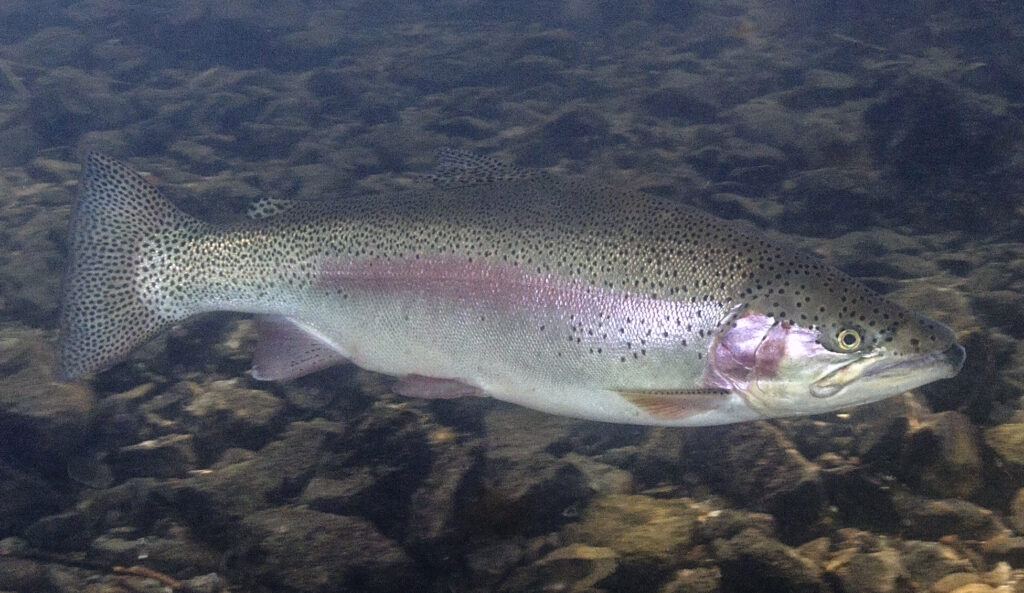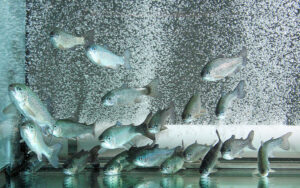by Joe Eaton

(Full article from RATS Tales February 2025)
German scientists continue to enlarge our understanding of the movement and effects of anticoagulant rodenticides (ARs) in freshwater ecosystems. Previous research in Germany had found ARs in fish in waterways near outflows from storm sewers where rat baits had been placed. Now a groundbreaking experimental study has demonstrated that rainbow trout are highly sensitive to the second-generation AR (SGAR) brodifacoum. Two additional publications document extensive AR exposure in a fish-eating mammal, the Eurasian otter, and two fish-eating birds, the great cormorant and the common merganser.
The trout study, published in Ecotoxicology and Environmental Safety, was conducted by Hannah Schmieg of the Bavarian Environment Agency and seven co-authors. Rainbow trout, native to Pacific Coast streams and introduced to every continent except Antarctica and several oceanic Islands, are prized sport and food fish, but not usually thought of as laboratory animals. To simulate natural food intake, the researchers used pelletized trout chow, specially formulated without the additional vitamin K found in commercial fish food—which would have affected the blood-clotting process—and spiked with brodifacoum.

The trout were divided into two test groups, one given a single dose of brodifacoum and observed for 15 days, the second fed every seven or eight days for up to 60 days. Both groups showed bleeding from the gills and prolonged blood clotting. In the 60-day experiment, the first fish died on day 17 and mortality increased from that point. The trout that died had exhibited anorexia, apathy (yes, fish can be apathetic), discoloration, and loss of swimming ability. Prolonged clotting occurred at average concentrations of 122.6 nanograms per gram in liver tissue, comparable to residues found in wild fish. The trout appeared to be more strongly affected than the bass, minnows, and triggerfish used in an earlier experimental study in which brodifacoum and the first-generation ARs (FGARs) diphacinone and chlorophacinone were injected rather than administered in food; the difference in method may account for the disparity.
The authors note that the deaths of the trout occurred at a concentration comparable to the lethal AR dose for barn owls, a species considered more sensitive to ARs than most birds. One of the authors, Hannah Schrader, says the group has also tested the SGAR bromadiolone; results have not yet been published.
Julia Regnery of the Federal Institute of Hydrology was lead author of the otter study, published in Science of the Total Environment, and the fish-eating bird study, which appeared in Environmental Chemistry Letters.
The otters, mostly roadkill casualties, were collected in northern and eastern Germany between 2005 and 2021. Of 122 carcasses analyzed, 82 had residues of at least one AR in their livers. Eight different ARs, including both first-generation and second-generation, were detected, brodifacoum most frequently. Otters from the state of Lower Saxony, which has a history of aggressive rodent control, had the highest AR residues. Although most of the otters appeared to have been in good condition, one young female that was positive for six ARs had apparent liver damage. This individual had an extremely high concentration of brodifacoum, 821 nanograms per gram. While AR levels overall were relatively low, five otters had concentrations exceeding the lethal dose for barn owls. ARs have also been found in otters in France, the United States, and South Africa.
The cormorants and mergansers had been killed between 2020 and 2023 to reduce predation pressure on endangered fish species—the grayling, a salmon relative, and the nase, a member of the carp family. Regnery and her co-authors also analyzed the carcasses of coypus (also known as nutria, large semi-aquatic plant-eating rodents from the American tropics which have become a pest species in Europe), as well as several freshwater fish species. Forty-six of 96 cormorants had AR liver residues, mainly SGARs: brodifacoum in 39, difenacoum in 23, bromadiolone in three. Results were similar for the mergansers, with detections in 13 of 29 birds and brodifacoum predominating. Concentrations ranged up to 35.1 nanograms per gram for cormorants and 9.4 nanograms for mergansers. Brodifacoum was also found in two fish species, the roach and the chub.
Significantly, only one of 42 coypus tested positive for ARs (difenacoum and brodifacoum), and no ARs were found in common nase, a plant-eating fish. Coupled with the fact that SGARs don’t readily dissolve in water, the differences between fish-eating and plant-eating species suggest that aquatic organisms are being exposed through something they eat rather than the water they swim in, with residues building up from primary consumers to secondary consumers and moving through the food web to apex predators like otters and fish-eating birds. But the precise exposure pathways remain unclear.
Rodenticide baits in sewers are a prime suspect, especially with the correlation between extreme weather events and downstream contamination. “The majority of [pest control] practitioners use bait blocks in the sewers,” Regnery explained in an e-mail. But a 2022 survey indicated that loose pellets and rodenticide-laced grain are used in sewer baiting, albeit in low numbers. “Bait blocks break down into smaller portions under moist/wet conditions,” she adds. “One research hypothesis is that invertebrates act as contamination vectors and can transmit anticoagulants in the food web. They are small enough to access bait stations and will feed on bait when they are attracted to it.” This could include terrestrial invertebrates such as cockroaches, or aquatic organisms that scavenge poisoned rodent carcasses that end up in water bodies. Otters, in particular, eat a lot of bottom-feeding crayfish. Research soon to be published should shed more light on these processes.
